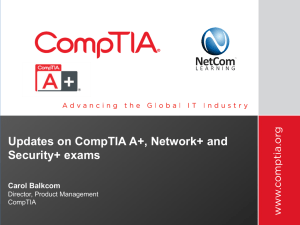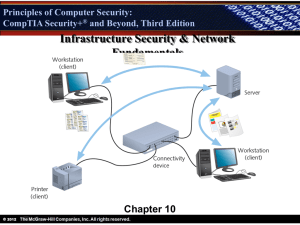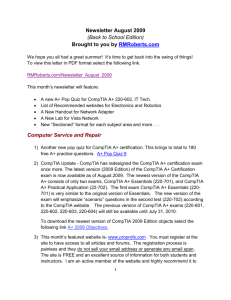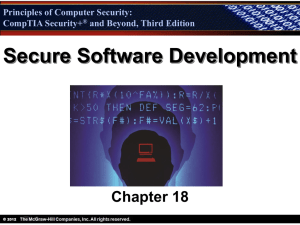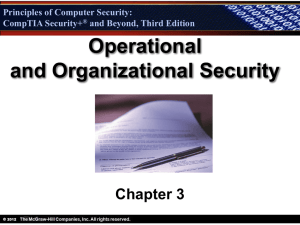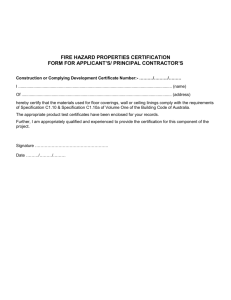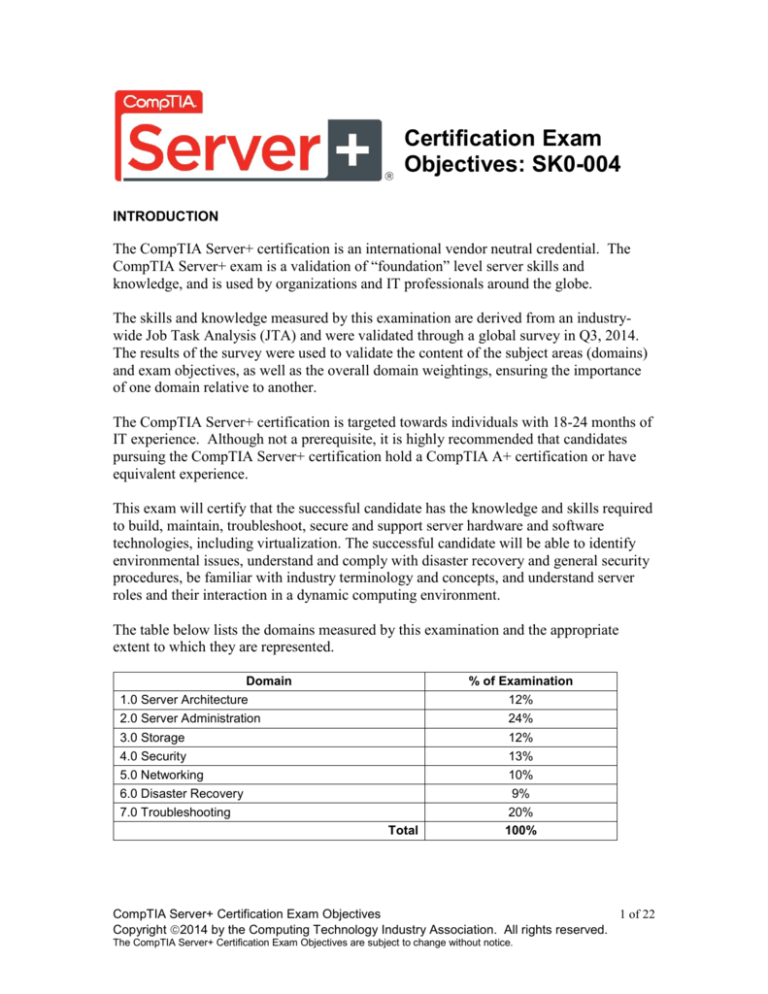
Certification Exam
Objectives: SK0-004
INTRODUCTION
The CompTIA Server+ certification is an international vendor neutral credential. The
CompTIA Server+ exam is a validation of “foundation” level server skills and
knowledge, and is used by organizations and IT professionals around the globe.
The skills and knowledge measured by this examination are derived from an industrywide Job Task Analysis (JTA) and were validated through a global survey in Q3, 2014.
The results of the survey were used to validate the content of the subject areas (domains)
and exam objectives, as well as the overall domain weightings, ensuring the importance
of one domain relative to another.
The CompTIA Server+ certification is targeted towards individuals with 18-24 months of
IT experience. Although not a prerequisite, it is highly recommended that candidates
pursuing the CompTIA Server+ certification hold a CompTIA A+ certification or have
equivalent experience.
This exam will certify that the successful candidate has the knowledge and skills required
to build, maintain, troubleshoot, secure and support server hardware and software
technologies, including virtualization. The successful candidate will be able to identify
environmental issues, understand and comply with disaster recovery and general security
procedures, be familiar with industry terminology and concepts, and understand server
roles and their interaction in a dynamic computing environment.
The table below lists the domains measured by this examination and the appropriate
extent to which they are represented.
Domain
% of Examination
1.0 Server Architecture
2.0 Server Administration
12%
24%
3.0 Storage
4.0 Security
5.0 Networking
6.0 Disaster Recovery
7.0 Troubleshooting
12%
13%
10%
9%
20%
100%
Total
CompTIA Server+ Certification Exam Objectives
1 of 22
Copyright 2014 by the Computing Technology Industry Association. All rights reserved.
The CompTIA Server+ Certification Exam Objectives are subject to change without notice.
CompTIA Authorized Materials Use Policy
CompTIA Certifications, LLC is not affiliated with and does not authorize, endorse or condone utilizing
any content provided by unauthorized third-party training sites, aka 'brain dumps'. Individuals who utilize
such materials in preparation for any CompTIA examination will have their certifications revoked and be
suspended from future testing in accordance with the CompTIA Candidate Agreement. In an effort to more
clearly communicate CompTIA’s exam policies on use of unauthorized study materials, CompTIA directs
all certification candidates to the CompTIA Certification Exam Policies webpage:
http://certification.comptia.org/Training/testingcenters/policies.aspx
Please review all CompTIA policies before beginning the study process for any CompTIA exam.
Candidates will be required to
abide by the CompTIA Candidate Agreement
(http://certification.comptia.org/Training/testingcenters/policies/agreement.aspx) at the time of exam
delivery.
If a candidate has a question as to whether study materials are considered unauthorized (aka brain dumps),
he/she should perform a search using CertGuard's
engine, found here:
http://www.certguard.com/search.asp
Or verify against this list:
http://certification.comptia.org/Training/testingcenters/policies/unauthorized.aspx
**Note: The lists of examples provided in bulleted format below each objective are not exhaustive lists.
Other examples of technologies, processes or tasks pertaining to each objective may also be included on the
exam although not listed or covered in this objectives document.
CompTIA is constantly reviewing the content of our exams and updating test questions to be sure our
exams are current and the security of the questions is protected. When necessary, we will publish updated
exams based on existing exam objectives. Please know that all related exam preparation materials will still
be valid.
(A list of acronyms used in these Objectives appears at the end of this document.)
CompTIA Server+ Certification Exam Objectives
2 of 22
Copyright 2014 by the Computing Technology Industry Association. All rights reserved.
The CompTIA Server+ Certification Exam Objectives are subject to change without notice.
1.0 Server Architecture
1.1 Explain the purpose and function of server form factors
Rack mount
o Dimensions
1U, 2U, 4U
o Cable management arms
o Rail kits
Tower
Blade technology
o Blade enclosure
Backplane / Midplane
Power supply sockets
Network modules / switches
Management modules
o Blade server
1.2 Given a scenario, install, configure and maintain server components
CPU
o Multiprocessor vs. multicore
o Socket type
o Cache levels: L1, L2, L3
o Speeds
Core
Bus
Multiplier
o CPU stepping
o Architecture
x86
x64
ARM
RAM
o ECC vs. non-ECC
o DDR2, DDR3
o Number of pins
o Static vs. dynamic
o Module placement
o CAS latency
o Timing
o Memory pairing
Bus types, bus channels and expansion slots
o Height differences and bit rate differences
o PCI
o PCIe
o PCI-X
NICs
Hard drives
Riser cards
RAID controllers
BIOS/UEFI
o CMOS battery
Firmware
USB interface/port
CompTIA Server+ Certification Exam Objectives
3 of 22
Copyright 2014 by the Computing Technology Industry Association. All rights reserved.
The CompTIA Server+ Certification Exam Objectives are subject to change without notice.
Hotswap vs. non-hotswap components
1.3 Compare and contrast power and cooling components
Power
o Voltage
110v vs. 220v vs. -48v
208v vs. 440v/460v/480v
o Wattage
o Consumption
o Redundancy
o 1-phase vs. 3-phase power
o Plug types
NEMA
Edison
Twist lock
Cooling
o Airflow
o Thermal dissipation
o Baffles / shrouds
o Fans
o Liquid cooling
2.0 Server Administration
2.1 Install and configure server operating systems
Determine server role/purpose
Update firmware
BIOS/UEFI configuration
o Boot order
Disk preparation
o RAID setup
o Partitioning
o Formatting
o File system type
Ext 2, 3, 4
NTFS
FAT32
ReiserFS
UFS
VMFS
ZFS
o Swap
Configure host name
Local account setup
Connect to network
Join domain/directory
Address security concerns
o Patching
o OS hardening
o Compliance to company procedures/standards
Enable services
Install features/roles/applications/drivers
Performance baseline
o Server optimization
o Swap or pagefile optimization
CompTIA Server+ Certification Exam Objectives
4 of 22
Copyright 2014 by the Computing Technology Industry Association. All rights reserved.
The CompTIA Server+ Certification Exam Objectives are subject to change without notice.
Unattended/remote installations
o Deploying images and cloning
o Scripted installs
PXE boot
TFTP
2.2 Compare and contrast server roles and requirements for each
Web server
Application server
Directory server
Database server
File server
Print server
Messaging server
Mail server
Routing and remote access server
Network services server
o DHCP
o DNS/WINS
o NTP
2.3 Given a scenario, use access and control methods to administer a server
Local hardware administration
o KVM
o Serial
o Virtual Administration console
Network-based hardware administration
o KVM over IP
o ILO
o iDRAC
Network-based operating system administration
o RDP
o SSH
o VNC
o Command line / shell
2.4 Given a scenario, perform proper server maintenance techniques
Change management
Patch management
o Operating System updates
o Application updates
o Security software updates
o Firmware updates
o Device drivers updates
o Compatibility lists
Operating systems
Hardware
Applications
o Testing and validation
Outages & Service Level Agreements
o Scheduled downtime
o Unscheduled downtime
o Impact analysis
o Client notification
o MTTR
CompTIA Server+ Certification Exam Objectives
5 of 22
Copyright 2014 by the Computing Technology Industry Association. All rights reserved.
The CompTIA Server+ Certification Exam Objectives are subject to change without notice.
Performance monitoring
o CPU utilization
o Memory utilization
o Network utilization
o Disk utilization
Disk IOPS
Storage capacity
o Comparison against performance baseline
o Processes and services monitoring
o Log monitoring
Hardware maintenance
o Check system health indicators
LEDs
Error codes
Beep codes
LCD messages
o Replace failed components
Fans
Hard drives
RAM
Backplanes
Batteries
o Preventative maintenance
Clearing dust
Check proper air flow
o Proper shut down procedures
Fault tolerance and high availability techniques
o Clustering
Active/active
Active/passive
o Load balancing
Round robin
Heartbeat
2.5 Explain the importance of asset management and documentation
Asset management
o Licensing
o Labeling
o Warranty
o Life cycle management
Procurement
Usage
End of life
Disposal/recycling
o Inventory
Make
Model
Serial number
Asset tag
Documentation
o Service manuals
o Network diagrams
o Architecture diagrams
o Dataflow diagrams
o Recovery documentation
o Baseline documentation
CompTIA Server+ Certification Exam Objectives
6 of 22
Copyright 2014 by the Computing Technology Industry Association. All rights reserved.
The CompTIA Server+ Certification Exam Objectives are subject to change without notice.
o Change management policies
o Service Level Agreement
o Server configuration
Secure storage of sensitive documentation
2.6 Explain the purpose and operation of virtualization components
Hosts and guests
Management interface for virtual machines
Hypervisor
o Type I
o Type II
o Hybrid
Hardware compatibility list
o BIOS/UEFI compatibility and support
o CPU compatibility support
o AMD-V / Intel VT
Resource allocation between Guest and Host
o CPU
o Storage
o Memory
o Network connectivity
Direct Access (Bridging) vs. NAT
Virtual NICs
Virtual switches
o Video
3.0 Storage
3.1 Given a scenario, install and deploy primary storage devices based on given
specifications and interfaces
Disk specifications
o RPM
o Dimensions/form factor
o Capacity
o Bus width
o IOPS
o Seek time and latency
o Hotswap vs. non-hotswap components
Interfaces
o SAS
o SATA
o SCSI
o USB
o Fiber Channel
Hard drive vs. SSD
3.2 Given a scenario, configure RAID using best practices
RAID levels and performance considerations
o 0
o 1
o 5
o 6
o 10
Software vs. hardware RAID
o Performance considerations
CompTIA Server+ Certification Exam Objectives
7 of 22
Copyright 2014 by the Computing Technology Industry Association. All rights reserved.
The CompTIA Server+ Certification Exam Objectives are subject to change without notice.
Configuration specifications
o Capacity
o Bus types
o Drive RPM
Hotswap support and ramifications
Hot spare vs. cold spare
Array controller
o Memory
o Battery backed cache
o Redundant controller
3.3 Summarize hardware and features of various storage technologies
DAS
NAS
o iSCSI
o FCoE
SAN
o Fiber Channel
o LUN & LUN masking
o HBAs and fabric switches
JBOD
Tape
o Drive
o Libraries
Optical drive
Flash, Compact Flash and USB drive
3.4 Given a scenario, calculate appropriate storage capacity and plan for future
growth
Base10 vs. Base2 disk size calculation (1000 vs. 1024)
Disk quotas
Compression
Capacity planning considerations:
o Operating system growth
Patches
Service packs
Log files
o Temporary directories
o Databases
o Application servers
o File servers
o Archival
4.0 Security
4.1 Compare and contrast physical security methods and concepts
Multifactor Authentication
o Something you have
o Something you know
o Something you are
Security concepts
o Mantrap
o RFID chip
o ID card
CompTIA Server+ Certification Exam Objectives
8 of 22
Copyright 2014 by the Computing Technology Industry Association. All rights reserved.
The CompTIA Server+ Certification Exam Objectives are subject to change without notice.
o
o
o
o
o
o
o
Biometric
Keypad
Access list
Security guard
Security camera
Keys & Locks
Cabinet
Rack mount
Server
Safe
4.2 Given a scenario, apply server hardening techniques
OS hardening
o Stopping unneeded services / closing unneeded ports
o Install only required software
o Install latest operating system patches
Application hardening
o Install latest patches
o Disabling unneeded services/roles/features
Endpoint security
o HIDS
o Anti-malware
Remediate security issues based on a vulnerability scan
Hardware hardening
o Disabling unneeded hardware and physical ports/devices
o BIOS password
o Disable WOL (Wake on LAN)
o Setup boot order
o Chassis locks / intrusion detection
4.3 Explain basic network security systems and protocols
Firewall
o Network-based
o Host-based
Port security / 802.1x / NAC
Router access list
NIDS
Authentication protocols
o LDAP
o RADIUS
o TACACS
o TACACS+
PKI
o Private key
o Public key
o Certificate authority
o SSL/TLS
VPN
IPSEC
VLAN
Security zones
o DMZ
o Public and private
o Intranet and extranet
CompTIA Server+ Certification Exam Objectives
9 of 22
Copyright 2014 by the Computing Technology Industry Association. All rights reserved.
The CompTIA Server+ Certification Exam Objectives are subject to change without notice.
4.4 Implement logical access control methods based on company policy
Access control lists
o Users
o Groups
Roles
o Resources
File system
Network ACLs
Peripheral devices
Administrative rights
Distribution lists
Permissions
o Read
o Write/Modify
o Execute
o Delete
o Full control/Superuser
o File vs. share
4.5 Implement data security methods and secure storage disposal techniques
Storage encryption
o File level encryption
o Disk encryption
o Tape encryption
Storage media
o Soft wipe
File deletion
o Hard wipe
Zero out all sectors
o Physical destruction
o Remote wipe
4.6 Given a scenario, implement proper environmental controls and techniques
Power concepts and best practices
o UPS
Runtime vs. capacity
Automated graceful shutdown of attached devices
Periodic testing of batteries
Maximum load
Bypass procedures
Remote management
o PDU
Connect redundant rack PDUs to separate circuits
o Capacity planning
PDU ratings
UPS ratings
Total potential power draw
o Multiple circuits
Connect redundant power supplies to separate PDUs
Safety
o ESD procedures
o Fire suppression
o Proper lifting techniques
o Rack stability
o Floor load limitations
o Sharp edges and pinch points
CompTIA Server+ Certification Exam Objectives
10 of 22
Copyright 2014 by the Computing Technology Industry Association. All rights reserved.
The CompTIA Server+ Certification Exam Objectives are subject to change without notice.
HVAC
o Room and rack temperature and humidity
Monitoring and alert notifications
o Air flow
Rack filler/baffle/blanking panels
o Hot aisle and cold aisle
5.0 Networking
5.1 Given a scenario, configure servers to use IP addressing and network
infrastructure services
IPv4 vs. IPv6
Default gateway
CIDR notation and subnetting
Public and private IP addressing
Static IP assignment vs. DHCP
DNS
o FQDN
o Default domain suffix / search domain
WINS
NetBIOS
NAT/PAT
MAC addresses
Network Interface Card configuration
o NIC teaming
o Duplexing
Full
Half
Auto
o Speeds
10/100/1000 Mbps
10 Gbps
5.2 Compare and contrast various ports and protocols
TCP vs. UDP
SNMP
161
SMTP
25
FTP
20/21
SFTP
22
SSH
22
SCP
22
NTP
123
HTTP
80
HTTPS
443
TELNET
23
IMAP
143
POP3
110
RDP
3389
FTPS
989/990
LDAP
389/3268
DNS
53
DHCP
68
CompTIA Server+ Certification Exam Objectives
11 of 22
Copyright 2014 by the Computing Technology Industry Association. All rights reserved.
The CompTIA Server+ Certification Exam Objectives are subject to change without notice.
5.3 Given a scenario, install cables and implement proper cable management
procedures
Copper
o Patch cables
Crossover
Straight through
Rollover
o CAT5
o CAT5e
o CAT6
Fiber
o Singlemode
o Multimode
Connectors
o ST
o LC
o SC
o SFP
o RJ-45
o RJ-11
Cable placement and routing
o Cable channels
o Cable management trays
Vertical
Horizontal
Labeling
Bend radius
Cable ties
6.0 Disaster Recovery
6.1 Explain the importance of disaster recovery principles
Site types
o Hot site
o Cold site
o Warm site
Replication methods
o Disk to disk
o Server to server
o Site to site
Continuity of Operations
o Disaster recovery plan
o Business continuity plan
o Business impact analysis
Who is affected
What is affected
Severity of impact
6.2 Given a scenario, implement appropriate backup techniques
Methodology
o Full/Normal
Copy
o Incremental
o Differential
o Snapshot
CompTIA Server+ Certification Exam Objectives
12 of 22
Copyright 2014 by the Computing Technology Industry Association. All rights reserved.
The CompTIA Server+ Certification Exam Objectives are subject to change without notice.
o Selective
o Bare metal
o Open file
o Data vs. OS restore
Backup media
o Linear Access
Tape
o Random Access
Disk
Removable media
Optical media
Media and restore best practices
o Labeling
o Integrity verification
o Test restorability
o Tape rotation and retention
Media storage location
o Offsite
o Onsite
o Security considerations
o Environmental considerations
7.0 Troubleshooting
7.1 Explain troubleshooting theory and methodologies
Identify the problem and determine the scope
o Question users/stakeholders and identify changes to the server /
environment
o Collect additional documentation / logs
o If possible, replicate the problem as appropriate
o If possible, perform backups before making changes
Establish a theory of probable cause (question the obvious)
o Determine whether there is a common element of symptom causing
multiple problems
Test the theory to determine cause
o Once theory is confirmed, determine next steps to resolve problem
o If theory is not confirmed, establish new theory or escalate
Establish a plan of action to resolve the problem and notify impacted users
Implement the solution or escalate as appropriate
o Make one change at a time and test/confirm the change has
resolved the problem
o If the problem is not resolved, reverse the change if appropriate and
implement new change
Verify full system functionality and if applicable implement preventative
measures
Perform a root cause analysis
Document findings, actions and outcomes throughout the process
7.2 Given a scenario, effectively troubleshoot hardware problems, selecting the
appropriate tools and methods
Common problems
o Failed POST
o Overheating
o Memory failure
CompTIA Server+ Certification Exam Objectives
13 of 22
Copyright 2014 by the Computing Technology Industry Association. All rights reserved.
The CompTIA Server+ Certification Exam Objectives are subject to change without notice.
o Onboard component failure
o Processor failure
o Incorrect boot sequence
o Expansion card failure
o Operating system not found
o Drive failure
o Power supply failure
o I/O failure
Causes of common problems
o Third party components or incompatible components
o Incompatible or incorrect BIOS
o Cooling failure
o Mismatched components
o Backplane failure
Environmental issues
o Dust
o Humidity
o Temperature
o Power surge / failure
Hardware tools
o Power supply tester (multimeter)
o Hardware diagnostics
o Compressed air
o ESD equipment
7.3 Given a scenario, effectively troubleshoot software problems, selecting the
appropriate tools and methods
Common problems
o User unable to logon
o User cannot access resources
o Memory leak
o BSOD / stop
o OS boot failure
o Driver issues
o Runaway process
o Cannot mount drive
o Cannot write to system log
o Slow OS performance
o Patch update failure
o Service failure
o Hangs no shut down
o Users cannot print
Cause of common problems
o User Account Control (UAC/SUDO)
o Corrupted files
o Lack of hard drive space
o Lack of system resources
o Virtual memory (misconfigured, corrupt)
o Fragmentation
o Print server drivers/services
o Print spooler
Software tools
o System logs
o Monitoring tools (resource monitor, performance monitor)
o Defragmentation tools
o Disk property tools (usage, free space, volume or drive mapping)
CompTIA Server+ Certification Exam Objectives
14 of 22
Copyright 2014 by the Computing Technology Industry Association. All rights reserved.
The CompTIA Server+ Certification Exam Objectives are subject to change without notice.
7.4 Given a scenario, effectively diagnose network problems, selecting the
appropriate tools and methods
Common problems
o Internet connectivity failure
o Email failure
o Resource unavailable
o DHCP server mis-configured
o Non-functional or unreachable
o Destination host unreachable
o Unknown host
o Default gateway mis-configured
o Failure of service provider
o Cannot reach by host name/FQDN
Causes of common problems
o Improper IP configuration
o VLAN configuration
o Port security
o Improper subnetting
o Component failure
o Incorrect OS route tables
o Bad cables
o Firewall (mis-configuration, hardware failure, software failure)
o Mis-configured NIC, routing / switch issues
o DNS and/or DHCP failure
o Mis-configured hosts file
o IPv4 vs. IPv6 misconfigurations
Networking tools
o ping
o tracert / traceroute
o ipconfig / ifconfig
o nslookup
o net use / mount
o route
o nbtstat
o netstat
7.5 Given a scenario, effectively troubleshoot storage problems, selecting the
appropriate tools and methods
Common problems
o Slow file access
o OS not found
o Data not available
o Unsuccessful backup
o Error lights
o Unable to mount the device
o Drive not available
o Cannot access logical drive
o Data corruption
o Slow I/O performance
o Restore failure
o Cache failure
o Multiple drive failure
Causes of common problems
o Media failure
o Drive failure
o Controller failure
CompTIA Server+ Certification Exam Objectives
15 of 22
Copyright 2014 by the Computing Technology Industry Association. All rights reserved.
The CompTIA Server+ Certification Exam Objectives are subject to change without notice.
o HBA failure
o Loose connectors
o Cable problems
o Mis-configuration
o Improper termination
o Corrupt boot sector
o Corrupt file system table
o Array rebuild
o Improper disk partition
o Bad sectors
o Cache battery failure
o Cache turned off
o Insufficient space
o Improper RAID configuration
o Mis-matched drives
o Backplane failure
Storage tools
o Partitioning tools
o Disk management
o RAID array management
o Array management
o System logs
o Net use / mount command
o Monitoring tools
7.6 Given a scenario, effectively diagnose security issues, selecting the
appropriate tools and methods
Common problems
o File integrity issue
o Privilege escalation
o Applications will not load
o Can’t access network file/shares
o Unable to open files
o Excessive access
o Excessive memory utilization
Causes of common problems
o Open ports
o Active services
o Inactive services
o Intrusion detection configurations
o Anti-malware configurations
o Local/group policies
o Firewall rules
o Misconfigured permissions
o Virus infection
o Rogue processes/services
Security tools
o Port scanners
o Sniffers
o Cipher
o Checksums
o Telnet client
o Anti-malware
CompTIA Server+ Certification Exam Objectives
16 of 22
Copyright 2014 by the Computing Technology Industry Association. All rights reserved.
The CompTIA Server+ Certification Exam Objectives are subject to change without notice.
SERVER+ ACRONYMS
Acronym
*nix
ACL
AD
AIT
AMD-V
ARM
BBWC
BIOS
BSOD
CAS
CAT5
CAT5e
CAT6
CIDR
CLI
CMOS
CPU
CRU
CUPS
DAS
DC
DDoS
DDR
DDR2
DDR3
DHCP
DLT
DMA
DMZ
DNS
DSRM
DTX
ECC
ESD
FAT
FCoE
Definition
Unix/Linux/Solaris/OS X/BSD
Access Control List
Active Directory
Advanced Intelligent Tape
AMD Virtualization
Advanced RISC Machines
Battery-Backed Write Cache
Basic Input/Output System
Blue Screen of Death
Column Address Strobe
Category 5
Category 5 enhanced
Category 6
Classless Inter-Domain Routing
Command Line Interpreter
Complementary Metal Oxide Semiconductor
Central Processing Unit
Customer Replaceable Unit
Common Unix Printing System
Direct Attached Storage
Domain Controller
Distributed Denial of Service
Double Data Rate
Double Data Rate2
Double Data Rate3
Dynamic Host Configuration Protocol
Digital Linear Tape
Direct Memory Access
Demilitarized Zone
Domain Name Service
Directory Services Restore Mode
Discontinuous Transmission
Error Correcting Code
Electrostatic Discharge
File Allocation Table
Fibre Channel over Ethernet
FQDN
Fully Qualified Domain Name
FRU
Field Replaceable Unit
FTP
FTPS
GFS
GPU
GUI
HBA
HCL
File Transfer Protocol
File Transfer Protocol over SSL
Grandfather Father Son
Graphics Processing Unit
Graphical User Interface
Host Bus Adapter
Hardware Compatibility List
CompTIA Server+ Certification Exam Objectives
17 of 22
Copyright 2014 by the Computing Technology Industry Association. All rights reserved.
The CompTIA Server+ Certification Exam Objectives are subject to change without notice.
HID
Human Interface Device
HIDS
Host Intrusion Detection System
HIPS
Host Intrusion Prevention System
HTTP
Hyper Text Transport Protocol
HTTPS
Secure Hyper Text Transport Protocol
HVAC
iDRAC
IIS
ILO
IMAP4
Intel-VT
IOPS
IP
IPMI
IPSEC
IPv6
iSCSI
Heating Ventilation and Air Conditioning
Integrated Dell Remote Access Control
Internet Information Services
Integrated Lights Out
Internet Mail Access Protocol
Intel Virtualization Technology
Input Output Operations per Second
Internet Protocol
Intelligent Platform Management Interface
Internet Protocol Security
Internet Protocol Version 6
Internetworking Small Computer System Interface
JBOD
Just a bunch of disks
KVM
Keyboard-Video-Mouse
LAN
Local Area Network
LC
Local Connector
LCD
Liquid Crystal Display
LDAP
Lightweight Directory Access Protocol
LED
Light Emitting Diode
LKGC
Last Known Good Configuration
LOM
LTO
LUN
MIB
MMC
MTTR
NAC
NAS
Lights Out Management
Linear Tape-Open
Logical Unit Number
Management Information Base
Microsoft Management Console
Mean Time To Recover
Network Access Control
Network Attached Storage
NAT
Network Address Translation
NEMA
National Electronic Manufacturers Association
NetBIOS
NIC
NIDS
NLB
Network Basic Input Output System
Network Interface Card
Network Intrusion Detection System
Network Load Balancing
NOS
NTFS
NTP
NX
Network Operating System
New Technology File System
Network Time Protocol
No Execute
OEM
Original Equipment Manufacturer
OS
Operating System
OSPF
Open Shortest Path First
CompTIA Server+ Certification Exam Objectives
18 of 22
Copyright 2014 by the Computing Technology Industry Association. All rights reserved.
The CompTIA Server+ Certification Exam Objectives are subject to change without notice.
OTDR
PAT
PBX
Optical Time Domain Reflectometer
Port Address Translation
Private Branch Exchange
PCI
Peripheral Component Interconnect
PCIe
PCI-X
PDU
PKI
POP3
POST
PXE
RADIUS
RAID
RAM
RAS
RDP
RFID
RIS
RISC
RJ-45
RPM
SAN
SAS
SATA
SC
SCP
SCSI
SDRAM
SFP
SFTP
SLA
SMP
SMTP
SNMP
SQL
SSD
SSH
SSL
ST
TACACS
TCP/IP
TDR
TFTP
TLS
UAC
UDP
UEFI
UFS
UID
Peripheral Component Interconnect Express
Peripheral Component Interconnect Extended
Power Distribution Unit
Public Key Infrastructure
Post Office Protocol (version 3)
Power on Self-Test
Preboot Execution Environment
Remote Authentication Dial-in User Service
Redundant Array of Inexpensive/Integrated Disks/Drives
Random Access Memory
Remote Access Server
Remote Desktop Protocol
Radio Frequency Indemnification
Remote Installation Service
Reduced Instruction Set Computer
Registered Jack 45
Rotations per Minute
Storage Area Network
Serial Attached SCSI
Serial ATA
Standard Connector
Secure Copy Protocol
Small Computer System Interface
Synchronous Dynamic Random Access Memory
Small Form Factor Pluggable
Secure File Transfer Protocol
Service Level Agreement
Symmetric Multiprocessing
Simple Mail Transport Protocol
Simple Network Management Protocol
Structured Query Language
Solid State Drive
Secure Shell
Secure Sockets Layer
Straight Tip
Terminal Access Controller Access Control System
Transmission Control Protocol / Internet Protocol
Time Domain Reflectometer
Trivial File Transfer Protocol
Transport Layer Security
User Account Control
User Datagram Protocol
Unified Extensible Firmware Interface
Unix File System
Unit Identification
CompTIA Server+ Certification Exam Objectives
19 of 22
Copyright 2014 by the Computing Technology Industry Association. All rights reserved.
The CompTIA Server+ Certification Exam Objectives are subject to change without notice.
UPS
USB
VLAN
VM
VMFS
VNC
VoIP
VPN
VRM
VSS
VT
WBEM
WDS
WINS
WMI
WOL
WORM
WSUS
XD
ZFS
Uninterruptible Power Supply
Universal Serial Bus
Virtual Local Area Network
Virtual Machine
VMWare File System
Virtual Network Computing
Voice over IP
Virtual Private Network
Voltage Regulator Module
Volume Shadow Service
Virtualization Technology
Web-based Enterprise Management
Windows Deployment Services
Windows Internet Naming Service
Windows Management Instrumentation
Wake on LAN
Write Once Read Many
Windows Software Update Services
Execute Disable
Zettabyte File System
CompTIA Server+ Certification Exam Objectives
20 of 22
Copyright 2014 by the Computing Technology Industry Association. All rights reserved.
The CompTIA Server+ Certification Exam Objectives are subject to change without notice.
Suggested Classroom Equipment to have for Server+ Certification Training
Equipment
Server
Multiple NICs
Remote management interface
RAID controller
SAS or SATA drives
Industry standard rack enclosure
Laptop or desktop
Switch
Ethernet cables
Fiber cables
Smart UPS
PDU
LCD screens
KVM
Serial cables
Thermostat
Cooling devices
Spare parts/hardware
Hard drive
RAM
Power supplies
Cables
Power cords
Cable/zip wraps
Tools
Digital multimeter
Screw driver
Wrench
Hammer
Flash light
Vacuum
Canned air
Cable testers
Software
Virtualization software
CompTIA Server+ Certification Exam Objectives
21 of 22
Copyright 2014 by the Computing Technology Industry Association. All rights reserved.
The CompTIA Server+ Certification Exam Objectives are subject to change without notice.
Various server operating systems (Windows/Linux)
Host-based security suite
Vulnerability assessment software
PuTTY
Packet analyzer
NMAP
CompTIA Server+ Certification Exam Objectives
22 of 22
Copyright 2014 by the Computing Technology Industry Association. All rights reserved.
The CompTIA Server+ Certification Exam Objectives are subject to change without notice.

